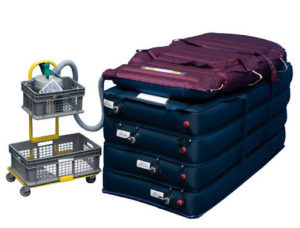

Thinking outside the box


Presentation: The service user is an Immobile Plus Size (Bariatric) service user who cannot tolerate hoisting.
Height: 6ft 3”
Weight: approx. 40 stone (255kg) weight is approximate as service user has not been weighed for 8yrs.
Medical history: Kidney failure, Congestive Heart Disease, Hypertension, History of TIA but not anything for a few years. The service user was using oxygen to support / assist with his breathing he is also on oramorphe for his pain management when needed.
A joint assessment at the request of the Lead Manual Handling Adviser was undertaken.
Current situation:
The service user is currently laying on his king-size double bed in the rear bedroom of a small bungalow. This is effecting the service user both physically & physiologically with support.
Consideration has to be given for the potential requirement for evacuation in the case of a fire, currently the service user would be trapped should this situation arise.
The Task:
To transfer the service user from his current bed system in the rear bedroom and place him on a new bed system in his front room.
A dynamic risk assessment of the needs of the service user, the environment and any other associated risk factors took place.
These will be communicated to the evacuation team by the lead Manual Handling Advisor at all times during the task.
The actual technique and equipment being used will be to laterally slide the service user off his current bed using the Hovertech system then back onto the new bed system.
The moving and handling advisor on site will give full and clear instructions to the team and no activity will be undertaken without full consent of the service user.
A trial run of the identified equipment choice and techniques was completed to assess potential problems.
It was agreed that the transfer should take place the following day 9th June.
The service user was informed and was made aware of the risks involved and that measures would be put in place should he have a medical episode during the transfer and if he needed to be transferred to hospital.
If at any time it is deemed the health of the service user is at risk from being moved the task will be stopped and the GP or emergency services will be contacted.
Issues Identified to be looked at:
All of his needs including his personal care are being completed by his wife.
To consider:
Observations and findings:
It was recommended that the use of the 39” Hovermat & HoverJack systems will enable safe and dignified transfer of the service user from the back bedroom and into the lounge area.
This system will reduce the risk of injury to both the service user and evacuation team completing the transfer.
The technique to be adopted is similar to that used for evacuating a patient in a confined space.
The hovermat will reduce the service users weight during handling from 100% to 17% as a result this will enable the evacuation team to so far as reasonably practicable move the service user in a safe and as dignified way possible.
The plan is to laterally transfer the service user off his current bed surface by inserting the 39” hovermat underneath him and inflating it, then laterally moving him onto the inflated HoverJack positioned next to his current bed.
The HoverJack will then be deflated taking the service user to the floor.
The Hovermat will then be inflated, two extension handles attached and the service user will be moved from his bedroom as in picture A and into passageway as in picture B.
The HoverJack shall be taken from the back bedroom and into the front lounge alongside the new bed system.
The hovermat shall then be inflated and the service user will be transferred into the lounge through doorway as per picture (C).
The service user will then be placed onto the HoverJack system the hovermat will be deflated.
The service user will be secured onto Hover Jack and raised off the floor surface alongside the new bed surface.
The service user shall then be laterally transferred from the HoverJack onto his new bed surface.
Minimum manpower needed will be 4.
Once transfer is completed an accurate weight of the service user shall be taken using the bed scales.
Estimated time to complete this task is approx. 3 hrs.
Picture (A) main bedroom

Picture (B) 1st passageway outside main bedroom door.

Picture (C) Final exit into main lounge area.

